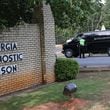There’s an abandoned garden hidden under some shade trees on the campus of Mount Vernon Presbyterian School, and students there are trying to figure out what if anything to do about it.
A second group of students is brainstorming ideas on how to improve the school’s “dining experience,” and a third is examining the excessive use of Styrofoam plates and cups by students and staff. Neon green, orange and pink sticky notes cover the tables and walls in an area just off the school’s stairway.
The hardest task of all may fall to group number four. They’ve decided to craft a new mission statement for the coursework they’re taking toward an “Innovation diploma.”
Put simply, high schoolers at the private school in Sandy Springs will graduate with two diplomas: a traditional one and another that tells college admissions officials and employers they’ve done some real-world thinking and problem solving in addition to mastering literature, algebra and biology.
About 25 students are enrolled in the diploma program, with more joining every year. They take coursework that is self-directed and centered around problem solving. They interact with professionals who approach Mount Vernon because of the school’s emphasis on design thinking, a process that involves brainstorming real-world problems and coming up with solutions.
In addition to taking the courses required for a traditional degree, students in the Innovation diploma program spend about seven hours a week — time that would normally be spent in electives — doing free form thinking and problem solving. Their work often involves all academic subject areas.
“Our students have the capabilities to be engaging, solving and curating problems in our community, and we give them a voice to make change,” said Meghan Cureton, director of the Innovation diploma program. “This gets them into the mindset, that I can do something about it.”
When employees from the Centers for Disease Control and Prevention approached teachers at the school about helping them brainstorm new approaches to their strategic health initiatives, Cureton engaged her Innovation diploma students in the process.
“It was a delight having the students and faculty of Mount Vernon join our public health experts from CDC’s National Center on Birth Defects and Developmental Disabilities in a design thinking workshop,” said Erica Reott, chief strategy officer. “Together we explored three public health topics that the center has identified as key action areas: identifying the safest treatment options for the management of common conditions before and during pregnancy; increasing the alignment of current practice and existing medical guidelines (best practices) for treatment of attention deficit/hyperactivity disorder (ADHD); and preventing a certain type of deadly blood clot, called hospital-associated venous thromboembolism.
“The students were mature, quick learners, and enthusiastic. I can definitely say the students provided insightful contributions that we value as we continue our work to address these important public health challenges.”
Earlier this year, Mount Vernon’s philanthropy team asked for help in coming up with a better, more personal way to thank its donors. The students suggested a piece of student artwork and a video that featured a teacher and student talking about how the donation helped their classwork.
Students in the Innovation diploma program believe the work they are doing will give them an edge in the college admissions process; the top question parents had about the program.
Anya Smith, a junior at Mount Vernon, says she’s now weighing her college choices differently as a result of the work she’s doing in the program.
“It’s made me realize there can be a lot more to school,” she said. “There are certain schools I can figure out quicker, ‘Yes, you are right for me; no, you’re not right for me’ based on how they approach learning. How do they think about what school means? You can have the facilities and you can have great professors, but if you’re not really about the real-world experience and actually helping other people, then why do we do all this learning? It’s to then better the world and better others.”
About the Author





